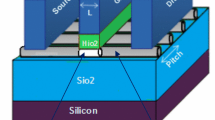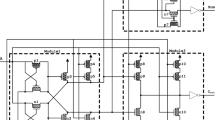Abstract
In this paper a low-power, high-speed and high-resolution voltage-mode Min-Max circuit, as well as a new efficient universal structure for determining the minimum and maximum values of the input digital signals, is proposed for nanotechnology. In addition, the proposed designs provide rail-to-rail input and output signals which enhance the performance and the robustness of the circuits. The advantage of the proposed Min-Max circuit is that it is extendable for any arbitrary n-digit and radix-r input numbers. Comprehensive simulation results at CMOS and CNFET technologies demonstrate the low-power and high-performance operation as well as insusceptibility to PVT variations of the proposed structure.
Similar content being viewed by others
References
K. Abdelhalim, L. MacEachern, S. Mahmoud, A nanowatt successive approximation ADC with offset correction for implantable sensor applications, in Proc. IEEE International Symposium on Circuits and Systems, May 27–30 (2007), pp. 2351–2354
A.K. Abu El-Seoud, M. El-Banna, M.A. Hakim, On modelling and characterization of single electron transistor. Int. J. Electron. 94(6), 573–585 (2007)
V. Adler, E.G. Friedman, Delay and power expressions for a CMOS inverter driving a resistive-capacitive load. Analog Integr. Circuits Signal Process. 14(1–2), 29–39 (1997)
A. Agnes, E. Bonizzoni, P. Malcovati, F. Maloberti, A 9.4-ENOB 1V 3.8uW 100kS/s SAR ADC with time-domain comparator, in Proc International Solid-State Circuits Conference, Feb. 3–7 (2008), pp. 246–610
J.S. Ajit, Y.-B. Kim, M. Choi, Performance assessment of analog circuits with carbon nanotube FET (CNFET), in Proc. 20th Great Lakes Symposium on VLSI, May 16–18 (2010), pp. 163–166
J.R. Angulo, J.E. Molinar-Solis, Sh. Gupta, R.G. Carvajal, A.J. López-Martín, A high-swing, high-speed CMOS WTA using differential flipped voltage followers. IEEE Trans. Circuits Syst. II 54(8), 668–672 (2007)
A. Balijepalli, S. Sinha, Yu CaoCompact, Modeling of carbon nanotube transistor for early stage process-design exploration, in Proc. International Symposium on Low Power Electronics and Design, Aug. 27–29 (2007), pp. 2–7
R.G. Carvajal, J. Martinez-Heredia, J. Ramirez-Angulo, High-speed high-precision Min/Max circuits in CMOS technology. Electron. Lett. 36(8), 697–699 (2000)
G. Cho, Y.-B. Kim, F. Lombardi, M. Choi, Performance evaluation of CNFET-based logic gates, in Proc. IEEE International Instrumentation and Measurement Technology Conference, May 5–7 (2009), pp. 909–912
A. Demosthenous, S. Smedley, J. Taylor, A CMOS analog winner-take-all network for large-scale applications. IEEE Trans. Circuits Syst. I 45(3), 300–304 (1998)
J. Deng, Device modeling and circuit performance evaluation for nanoscale devices: silicon technology beyond 45 nm node and carbon nanotube field effect transistors. Doctoral dissertation, Stanford University, 2007
J. Deng, H.-S.P. Wong, A compact SPICE model for carbon-nanotube field-effect transistors including nonidealities and its application—Part II: Full device model and circuit performance benchmarking. IEEE Trans. Electron Devices 54(12), 3195–3205 (2007)
J. Deng, H.-S.P. Wong, A compact SPICE model for carbon-nanotube field-effect transistors including nonidealities and its application—Part I: Model of the intrinsic channel region. IEEE Trans. Electron Devices 54(12), 3186–3194 (2007)
R. Długosz, T. Talaśka, Low power current-mode binary-tree asynchronous Min/Max circuit. Microelectron. J. 41(1), 64–73 (2010)
K. El Shabrawy, K. Maharatna, D. Bagnall, B.M. Al-Hashimi, Modeling SWCNT bandgap and effective mass variation using a Monte Carlo approach. IEEE Trans. Nanotechnol. 9(2), 184–193 (2010)
C.J.B. Fayomi, G.W. Roberts, Design and characterization of low-voltage analog switch without the need for clock boosting, in Proc. the 47th International Midwest Symposium on Circuits and Systems, Jul. 25–28 (2004), pp. 315–318
R. Gregorian, Introduction to CMOS OP-AMPs and Comparators (Wiley, New York, 1999)
Z.S. Gunay, E. Sanchez-Sinencio, CMOS winner-take-all circuits: a detail comparison, in Proc. IEEE International Symposium on Circuits and Systems, Jun. 9–12 (1997), pp. 41–44
Y. He, E. Shnchez-Sinencio, Min-net winner-take-all CMOS implementation. Electron. Lett. 29(14), 1237–1239 (1993)
S. Ju, Maximum/minimum value determination apparatus. United States Patent, 5894426, 1999
S. Kazemi Nia, A. Khoei, Kh. Hadidi, High speed high precision voltage-mode MAX and MIN circuits. J. Circuits Syst. Comput. 16(2), 233–244 (2007)
T.J. Kazmierski, D. Zhou, B.M. Al-Hashimi, HSPICE implementation of a numerically efficient model of CNT transistor, in Proc. Forum on Specification and Design Languages, Sept. 22–24 (2009), pp. 1–5
P. Keshavarzian, K. Navi, Universal ternary logic circuit design through carbon nanotube technology. Int. J. Nanotechnol. 6(10–11), 942–953 (2009)
Y.-B. Kim, Y.-B. Kim, High speed and low power transceiver design with CNFET and CNT bundle interconnect, in Proc. IEEE International SOC Conference, Sep. (2010), pp. 152–157
Y.B. Kim, Y.-B. Kim, F. Lombardi, Novel design methodology to optimize the speed and power of the CNTFET circuits, in Proc. IEEE International Midwest Symposium on Circuits and Systems, Aug. 2–5 (2009), pp. 1130–1133
J.-L. Lai, Z.-X. Guan, Y.-T. Chen, C.-F. Tai, R.-J. Chen, Implementation of fuzzy cellular neural network with image sensor in CMOS technology, in Proc. International Conference on Communications, Circuits and Systems, May 25–27 (2008), pp. 982–986
S. Lin, Y.-B. Kim, F. Lombardi, Y.J. Lee, A new SRAM cell design using CNTFETs, in Proc. IEEE International SoC Design Conference, Nov. 24–25 (2008), pp. 168–171
S. Lin, Y.-B. Kim, F. Lombardi, A novel CNFET based ternary logic gate design, in Proc. IEEE International Midwest Symposium on Circuits and Systems, Aug. 2–5 (2009), pp. 435–438
B. Maundy, Min/Max circuit for analog convolutional decoders. IEEE Trans. Circuits Syst. II, Analog Digit. Signal Process. 48(8), 701–705 (2001)
M.H. Moaiyeri, A. Doostaregan, K. Navi, Design of energy-efficient and robust ternary circuits for nanotechnology. IET, Circuits Devices Syst. 5(4), 285–296 (2010)
M.H. Moaiyeri, R. Faghih Mirzaee, K. Navi, T. Nikoubin, O. Kavehei, Novel direct designs for 3-input XOR function for low-power and high-speed applications. Int. J. Electron. 97(6), 647–662 (2010)
M.H. Moaiyeri, R. Faghih Mirzaee, K. Navi, O. Hashemipour, Efficient CNTFET-based ternary full Adder cells for nanoelectronics. Nano-Micro Lett. 3(1), 43–50 (2011)
K. Navi, M.H. Moaiyeri, R. Faghih Mirzaee, O. Hashemipour, B. Mazloom Nezhad, Two new low-power full adders based on majority-not gates. Microelectron. J. 40(1), 126–130 (2009)
I.E. Opris, Rail-to-rail multiple-input Min/Max circuit. IEEE Trans. Circuits Syst. II, Analog Digit. Signal Process. 45(1), 137–140 (1998)
Y. Ota, B.M. Wilamowski, CMOS implementation of a voltage-mode fuzzy Min-Max controller. J. Circuits Syst. Comput. 6(2), 171–184 (1996)
P. Prommee, K. Angkeaw, M. Somdunyakanok, K. Dejhan, CMOS-based near zero-offset multiple inputs Max–Min circuits and its applications. Analog Integr. Circuits Signal Process. 61(1), 93–105 (2009)
P. Prommee, K. Chattrakun, CMOS WTA maximum and minimum circuits with their applications to analog switch and rectifiers. Microelectron. J. 42(1), 52–62 (2011)
J. Ramírez-Angulo, R. Gonzalez-Carvajal, G.O. Ducoudray, A.J. López-Martín, A. Torralba, New compact CMOS continuous-time low-voltage analog rank-order filter architecture. IEEE Trans. Circuits Syst. 51(5), 257–261 (2004)
A. Raychowdhury, K. Roy, Carbon nanotube electronics: design of high-performance and low-power digital circuits. IEEE Trans. Circuits Syst. 54(11), 2391–2401 (2007)
A. Roychowdhury, K. Roy, Carbon-nanotube-based voltage-mode multiple-valued logic design. IEEE Trans. Nanotechnol. 4(2), 168–179 (2005)
H. Shahidipour, A. Ahmadi, K. Maharatna, Effect of variability in SWCNT-based logic gates, in Proc. International Symposium on Integrated Circuits, Dec. 14–16 (2009), pp. 252–255
S. Siskos, S. Vlassis, I. Pitas, Analog implementation of fast Min/Max filtering. IEEE Trans. Circuits Syst. II, Analog Digit. Signal Process. 45(7), 913–918 (1998)
M. Soleimani, A. Khoei, Kh. Hadidi, S. Kazeminia, Design of high-speed high-precision voltage-mode MAX-MIN circuits with low area and low power consumption, in Proc. European Conference on Circuit Theory and Design, Aug. 23–27 (2009), pp. 351–354
M.A. Tehrani, F. Safaei, M.H. Moaiyeri, K. Navi, Design and implementation of multi-stage interconnection networks using quantum-dot cellular automata. Microelectron. J. 42(6), 913–922 (2011)
S. Vlassis, K. Doris, S. Siskos, I. Pitas, Analog implementation of erosion/dilation, median and order statistics filters. Pattern Recognit. 33(6), 1023–1032 (2000)
Author information
Authors and Affiliations
Corresponding author
Rights and permissions
About this article
Cite this article
Moaiyeri, M.H., Chavoshisani, R., Jalali, A. et al. High-Performance Mixed-Mode Universal Min-Max Circuits for Nanotechnology. Circuits Syst Signal Process 31, 465–488 (2012). https://doi.org/10.1007/s00034-011-9344-3
Received:
Revised:
Published:
Issue Date:
DOI: https://doi.org/10.1007/s00034-011-9344-3




